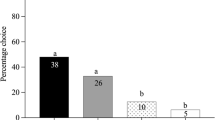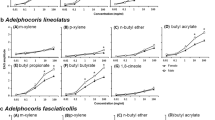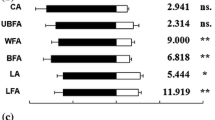Abstract
Herbivores emit plant-associated volatile organic compounds (VOCs) after feeding on plants. These plant-associated VOCs can be used by parasitoids to locate their hosts. It is hypothesized that certain compounds play key roles in the attractiveness of host-associated odor blends. The larval parasitoid, Microplitis croceipes (Hymenoptera: Braconidae) and its herbivore host, Heliothis virescens (Lepidoptera: Noctuidae), a major pest of cotton plant were used as model species to identify key compounds mediating attraction of parasitoids to hosts. Comparative GC/MS analyses of cotton-fed vs. artificial diet-fed hosts indicated that 12 of 17 compounds in the headspace of H. virescens larvae were exclusive to plant-fed hosts, and thus considered to be plant-associated. In order to identify key attractive compounds, a full blend of 15 commercially available synthetic compounds was modified by removing each of the 10 plant-associated compounds emitted by host larvae. In Y-tube olfactometer bioassays testing parasitoid responses to modified blends, 1-octen-3-ol, decanal, (E)-β-caryophyllene, α-humulene, α-farnesene, and β-pinene were identified as key compounds contributing to attractiveness of the natural blend of VOCs emitted by cotton-fed hosts. The results showed that while various host-associated compounds act in concert to serve as useful host location cues, only a fraction of the natural blend mediates attraction in parasitoids. Furthermore, the role of a compound is better assessed in the context of other compounds, and odor blends are better perceived as a whole rather than as individual components.






Similar content being viewed by others
References
Afsheen S, Xia W, Ran L, Chuan-Shu Z, Yong-Gen L (2008) Differential attraction of parasitoids in relation to specificity of kairomones from herbivores and their by-products. Insect Sci 15:381–397
Alborn HT, Lewis WJ, Tumlinson JH (1995) Host-specific recognition kairomone for the parasitoid Microplitis croceipes (Cresson). J Chem Ecol 21:1697–1708
Beyaert I, Wäschke N, Scholz A, Varama M, Reinecke A, Hilker M (2010) Relevance of resource-indicating key volatiles and habitat odour for insect orientation. Anim Behav 79:1077–1086
Bruce TJA, Pickett JA (2011) Perception of plant volatile blends by herbivorous insects - finding the right mix. Phytochemistry 72:1605–1611
Cha DH, Adams T, Rogg H, Landolt PJ (2012) Identification and field evaluation of fermentation volatiles from wine and vinegar that mediate attraction of spotted wing Drosophila, Drosophila suzukii. J Chem Ecol 38:1419–1431
Chesnais Q, Ameline A, Doury G, Le Roux V, Couty A (2015) Aphid parasitoid mothers don’t always know best through the whole host selection process. PLoS One 10:1–16
Chuche J, Xuéreb A, Thiéry D (2006) Attraction of Dibrachys cavus (Hymenoptera: Pteromalidae) to its host frass volatiles. J Chem Ecol 32:2721–2731
Clavijo McCormick A, Unsicker SB, Gershenzon J (2012) The specificity of herbivore-induced plant volatiles in attracting herbivore enemies. Trends Plant Sci 17:303–310
Clavijo McCormick A, Gershenzon J, Unsicker SB (2014) Little peaks with big effects: establishing the role of minor plant volatiles in plant-insect interactions. Plant Cell Environ 37:1836–1844
Colazza S, McElfresh JS, Millar JG (2004) Identification of volatile synomones, induced by Nezara viridula feeding and oviposition on bean spp., that attract the egg parasitoid: Trissolcus basalis. J Chem Ecol 30:945–964
Colazza S, Cusumano A, Lo Giudice D, Peri E (2014) Chemo-orientation responses in hymenopteran parasitoids induced by substrate-borne semiochemicals. BioControl 59:1–17
D’Alessandro M, Turlings TCJ (2005) In situ modification of herbivore-induced plant odors: a novel approach to study the attractiveness of volatile organic compounds to parasitic wasps. Chem Senses 30:739–753
D’Alessandro M, Brunner V, von Mérey G, Turlings TCJ (2009) Strong attraction of the parasitoid Cotesia marginiventris towards minor volatile compounds of maize. J Chem Ecol 35:999–1008
De Moraes CM, Lewis WJ, Paré PW, Alborn HT, Tumlinson JH (1998) Herbivore-infested plants selectively attract parasitoids. Nature 393:570–573
de Rijk M, Dicke M, Poelman EH (2013) Foraging behaviour by parasitoids in multiherbivore communities. Anim Behav 85:1517–1528
de Rijk M, Krijn M, Jenniskens W, Engel B, Dicke M, Poelman EH (2016) Flexible parasitoid behaviour overcomes constraint resulting from position of host and nonhost herbivores. Anim Behav 113:125–135
Delury NC, Gries R, Gries G, Judd GJR, Khaskin G (1999) Moth scale-derived kairomones used by egg-larval parasitoid Ascogaster quadridentata to locate eggs of its host, Cydia pomonella. J Chem Ecol 25:2419–2431
Despres L, David J, Gallet C (2007) The evolutionary ecology of insect resistance to plant chemicals. Trends Ecol Evol 22:298–307
Dweck HKM, Svensson GP, Gündüz EA, Anderbrant O (2010) Kairomonal response of the parasitoid, Bracon hebetor Say, to the male-produced sex pheromone of its host, the greater waxmoth, Galleria mellonella (L.). J Chem Ecol 36:171–178
Ed Sauls C, Nordlund DA, Lewis WJ (1979) Kairomones and their use for management of entomophagous insects VIII. Effect of diet on the kairomonal activity of frass from Heliothis zea (Boddie) larvae for Microplitis croceipes (Cresson). J Chem Ecol 5:363–369
Elzen GW, Williams HJ, Vinson SB (1984) Role of diet in host selection of Heliothis virescens by parasitoid Campoletis sonorensis (Hymenoptera: Ichneumonidae). J Chem Ecol 10:1535–1541
Faucher C, Forstreuter M, Hilker M, de Bruyne M (2006) Behavioral responses of Drosophila to biogenic levels of carbon dioxide depend on life-stage, sex and olfactory context. J Exp Biol 209:2739–2748
Fürstenberg-Hägg J, Zagrobelny M, Bak S (2013) Plant defense against insect herbivores. Int J Mol Sci 14:10242–10297
Goubault M, Plantegenest M, Poinsot D, Cortesero AM (2003) Effect of expected offspring survival probability on host selection in a solitary parasitoid. Entomol Exp Appl 109:123–131
Hofstetter RW, Raffa KF (1997) Effects of host diet on the orientation, development, and subsequent generations of the gypsy moth (Lepidoptera: Lymantriidae) egg parasitoid Ooencyrtus kuvanae (Hymenoptera: Encyrtidae). Environ Entomol 26:1276–1282
Isberg E, Bray DP, Birgersson G, Hillbur Y, Ignell R (2016) Identification of cattle-derived volatiles that modulate the behavioral response of the biting midge Culicoides nubeculosus. J Chem Ecol 42:24–32
Kappers IF, Aharoni A, van Herpen TWJM, Luckerhoff LLP, Dicke M, Bouwmeester HJ (2005) Genetic engineering of terpenoid metabolism attracts bodyguards to Arabidopsis. Science 309:2070–2072
Kelling FJ, Ialenti F, Den Otter CJ (2002) Background odour induces adaptation and sensitization of olfactory receptors in the antennae of houseflies. Med Vet Entomol 16:161–169
Lewis WJ, Burton RL (1970) Rearing Microplitis croceipes in the laboratory with Heliothis zea as host. J Econ Entomol 63:656–658
Logan JG, Birkett MA, Clark SJ et al (2008) Identification of human-derived volatile chemicals that interfere with attraction of Aedes aegypti mosquitoes. J Chem Ecol 34:308–322
Loughrin JH, Manukian A, Heath RR, Turlings TCJ, Tumlinson JH (1994) Diurnal cycle of emission of induced volatile terpenoids by herbivore-injured cotton plant. Proc Natl Acad Sci U S A 91:11836–11840
Magalhães DM, Borges M, Laumann RA, Sujii ER, Mayon P, Caulfield JC, Midega CAO, Khan ZR, Pickett JA, Birkett MA, Blassioli-Moraes MC (2012) Semiochemicals from herbivory induced cotton plants enhance the foraging behavior of the cotton boll weevil, Anthonomus grandis. J Chem Ecol 38:1528–1538
McCall PJ, Turlings CJ, Loughrin J, Proviouex AT, Tumlinson JH (1994) Herbivore-induced volatiles from cotton (Gossypium hirsutum L.) seedlings. J Chem Ecol 20:3039–3050
Molnár BP, Tóth Z, Fejes-Tóth A, Dekker T, Kárpáti Z (2015) Electrophysiologically-active maize volatiles attract gravid female european corn borer. Ostrinia nubilalis J Chem Ecol:997–1005
Morawo T, Fadamiro H (2014a) Duration of plant damage by host larvae affects attraction of two parasitoid species (Microplitis croceipes and Cotesia marginiventris) to cotton: implications for interspecific competition. J Chem Ecol 40:1176–1185
Morawo T, Fadamiro H (2014b) Attraction of two larval parasitoids with varying degree of host specificity to single components and a binary mixture of host-related plant volatiles. Chemoecology 24:127–135
Mumm R, Hilker M (2005) The significance of background odour for an egg parasitoid to detect plants with host eggs. Chem Senses 30:337–343
Nettles WC (1980) Adult Eucelatoria sp.: response to volatiles from cotton and okra plants and from larvae of Heliothis virescens, Spodoptera eridania, and Estigmene acrea. Environ Entomol 9:759–763
Ngumbi E, Fadamiro H (2012) Species and sexual differences in behavioural responses of a specialist and generalist parasitoid species to host-related volatiles. Bull Entomol Res 102:710–718
Ngumbi E, Chen L, Fadamiro HY (2009) Comparative GC-EAD responses of a specialist (Microplitis croceipes) and a generalist (Cotesia marginiventris) parasitoid to cotton volatiles induced by two caterpillar species. J Chem Ecol 35:1009–1020
Nojima S, Jr CL, Morris B, Zhang A, Roelofs W (2003) Identification of host fruit volatiles from hawthorn (Crataegus spp.) attractive to hawthorn-origin Rhagoletis pomonella flies. J Chem Ecol 29:321–336
Pare PW, Tumlinson JH (1999) Plant volatiles as a defense against insect herbivores. Plant Physiol 121:325–332
Peñaflor MFGV, Erb M, Miranda LA, Werneburg AG, Bento JMS (2011) Herbivore-induced plant volatiles can serve as host location cues for a generalist and a specialist egg parasitoid. J Chem Ecol 37:1304–1313
Reis J, Oliveira L, Garcia P (2003) Effects of the larval diet of Pseudaletia unipuncta (Lepidoptera: Noctuidae) on the performance of the parasitoid Glyptapanteles militaris (Hymenoptera: Braconidae). Environ Entomol 32:180–186
Röse USR, Tumlinson JH (2004) Volatiles released from cotton plants in response to Helicoverpa zea feeding damage on cotton flower buds. Planta 218:824–832
Röse USR, Lewis WJ, Tumlinson JH (1998) Specificity of systemically released cotton volatiles as attractants for specialist and generalist parasitic wasps. J Chem Ecol 24:303–319
Sasso R, Iodice L, Cristina Digilio M, Carretta A, Ariati L, Guerrieri E (2007) Host-locating response by the aphid parasitoid Aphidius ervi to tomato plant volatiles. J Plant Interact 2:175–183
Schnee C, Köllner TG, Held M, Turlings TCJ, Gershenzon DJ (2006) The products of a single maize sesquiterpene synthase form a volatile defense signal that attracts natural enemies of maize herbivores. Proc Natl Acad Sci U S A 103:1129–1134
Schröder R, Hilker M (2008) The relevance of background odor in resource location by insects: a behavioral approach. Bioscience 58:308
Shorey HH, Hale RL (1965) Mass-rearing of the larvae of nine Noctuid species on a simple artificial medium. J Econ Entomol 58:522–524
Sobhy IS, Erb M, Turlings TCJ (2015) Plant strengtheners enhance parasitoid attraction to herbivore-damaged cotton via qualitative and quantitative changes in induced volatiles. Pest Manag Sci 71:686–693
Steiner S, Erdmann D, Steidle JLM, Ruther J (2007) Host habitat assessment by a parasitoid using fungal volatiles. Front Zool 4:3
Sullivan BT, Pettersson EM, Seltmann KC, Berisford CW (2000) Attraction of the bark beetle parasitoid Roptrocerus xylophagorum (Hymenoptera: Pteromalidae) to host-associated olfactory cues. Environ Entomol 29:1138–1151
Takemoto H, Takabayashi J (2015) Parasitic wasps Aphidius ervi are more attracted to a blend of host-induced plant volatiles than to the independent compounds. J Chem Ecol 41:801–807
Turlings TCJ, Wäckers F (2004) Recruitment of predators and parasitoids by herbivore-injured plants. Adv Insect Chem Ecol 2:21–75
Turlings TC, Loughrin JH, McCall PJ, Rose USR, Lewis WJ, Tumlinson JH (1995) How caterpillar-damaged plants protect themselves by attracting parasitic wasps. Proc Natl Acad Sci U S A 92:4169–4174
Uefune M, Kugimiya S, Sano K, Takabayashi J (2012) Herbivore-induced plant volatiles enhance the ability of parasitic wasps to find hosts on a plant. J Appl Entomol 136:133–138
van Dam NM, Qiu B, Hordijk CA, Vet LEM, Jansen JJ (2010) Identification of biologically relevant compounds in aboveground and belowground induced volatile blends. J Chem Ecol 36:1006–1016
van Wijk M, de Bruijn PJA, Sabelis MW (2011) Complex odor from plants under attack: Herbivore’s enemies react to the whole, not its parts. PLoS One 6:e21742
Vet LEM, Dicke M (1992) Ecology of infochemical use by natural enemies in a tritrophic context. Annu Rev Entomol 37:141–172
Visser J (1986) Host odor perception in phytophagous insects. Annu Rev Entomol 31:121–144
Wajnberg É, Haccou P (2008) Statistical tools for analyzing data on behavioral ecology of insect parasitoids. In: Wajnberg É, Bernstein C, van Alphen J (eds) Behavioral ecology of insect parasitoids: from theoretical approaches to field. Blackwell Publishing Ltd, Oxford, UK, pp. 402–429
Wajnberg É, Bernstein C, van Alphen J (2008) Behavioral ecology of insect parasitoids : from theoretical approaches to field applications. Wiley-Blackwell, Malden, MA
Webster B, Bruce T, Pickett J, Hardie J (2010) Volatiles functioning as host cues in a blend become nonhost cues when presented alone to the black bean aphid. Anim Behav 79:451–457
Wei J-R, Lu X, Jiang L (2013) Monoterpenes from larval frass of two Cerambycids as chemical cues for a parasitoid, Dastarcus helophoroides. J Insect Sci 13:59
Zebelo S, Piorkowski J, Disi J, Fadamiro H (2014) Secretions from the ventral eversible gland of Spodoptera exigua caterpillars activate defense-related genes and induce emission of volatile organic compounds in tomato, Solanum lycopersicum. BMC Plant Biol 14:140
Acknowledgments
We thank Savannah Duke and Lindsay MacMillan for rearing the insects used for this study. This study was supported by Auburn University and the Alabama Agricultural Experiment Station.
Author information
Authors and Affiliations
Corresponding author
Rights and permissions
About this article
Cite this article
Morawo, T., Fadamiro, H. Identification of Key Plant-Associated Volatiles Emitted by Heliothis virescens Larvae that Attract the Parasitoid, Microplitis croceipes: Implications for Parasitoid Perception of Odor Blends. J Chem Ecol 42, 1112–1121 (2016). https://doi.org/10.1007/s10886-016-0779-7
Received:
Revised:
Accepted:
Published:
Issue Date:
DOI: https://doi.org/10.1007/s10886-016-0779-7




